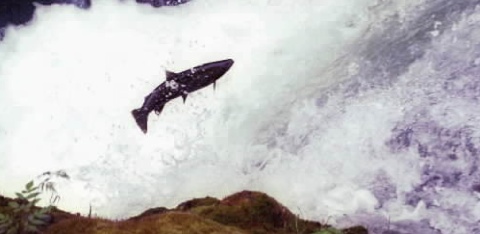forum
library
tutorial
contact

Northwest Salmon Recovery Plan
May Include Breaching Dams
by Les BlumenthalKansas City Star, September 15, 2009
|
the film forum library tutorial contact |

|
Northwest Salmon Recovery Plan
by Les Blumenthal |
 In a case closely followed by environmental and business interests, a rewritten plan for restoring endangered and threatened wild salmon runs on the Columbia and Snake rivers in Washington state and Idaho includes studying the possibility of breaching four major hydroelectric dams if other steps don't reverse the decline.
In a case closely followed by environmental and business interests, a rewritten plan for restoring endangered and threatened wild salmon runs on the Columbia and Snake rivers in Washington state and Idaho includes studying the possibility of breaching four major hydroelectric dams if other steps don't reverse the decline.
The revised Northwest plan, known as a biological opinion, was submitted Tuesday by the Obama administration to U.S. District Judge James Redden in Portland, Ore., who had been critical of a previous plan submitted by the Bush administration that rejected even a study of breaching the four dams on the lower Snake River.
The Obama proposal leaves much of Bush's plan intact. But it now includes an "aggressive" implementation section: A precipitous decline in the Snake River runs would trigger the dam breaching study. Congress would have to authorize any actual breaching.
"This is considered a contingency of last resort and would be recommended to Congress only when the best scientific information available indicates dam breaching would be effective and is necessary to avoid jeopardizing the continued existence of the affected Snake River species," the administration said.
The "best available science" does not justify moving forward with dam breaching now, the administration said.
The string of more than a dozen federal dams on the two rivers is not the only problem the salmon face. Loss of habitat, climate change, questionable hatchery policies, increasingly warm water and invasive nonnative fish all take a toll. But breaching the four dams has always been the most controversial proposal for recovering the 13 wild salmon and steelhead runs protected under the Endangered Species Act.
The Obama plan drew sharp criticism from environmentalists who felt the dams should be breached immediately and from lawmakers who said dam breaching shouldn't even be studied.
Michael Garrity, Washington conservation director for American Rivers in Seattle, said the salmon runs were already in near desperate shape and that the threshold for triggering a study was set so high that it might be too late to revive the runs.
"Unfortunately, the new administration has kept the 2008 Bush salmon plan intact, which sets the bar so low that many Columbia and Snake river salmon and steelhead runs will remain at high risk of extinction," Garrity said.
Republican Rep. Doc Hastings, whose eastern Washington district includes large swaths of the Columbia River Basin, said the Obama administration was catering to environmental extremists.
"The Obama administration has put dam removal back on the table and delivered just what dam removal extremists have been demanding," Hastings said. "No one should be fooled by talk of dam removal as a last resort when the Obama administration is immediately launching studies and plans for action."
Groups representing farmers, utilities, ports and other river-related businesses praised the administration for supporting much of the Bush plan, but they were critical of the dam-breaching study.
"Even talking about destroying the dams is nonsensical," said Terry Flores, executive director of Northwest RiverPartners.
Sen. Patty Murray, D-Wash., who opposes breaching the dams, noted that the Obama plan was "scientifically and biologically sound" and was developed following meetings with various groups in the region.
At one time, the runs totaled an estimated 10 million to 15 million salmon. No one is quite sure how many there are today.
The four dams - Ice Harbor, Lower Monumental, Little Goose and Lower Granite - produce enough cheap electricity to supply a city roughly the size of Seattle. The dams also have allowed barges to carry wheat from as far away as the High Plains downstream to West Coast ports for export overseas.
But critics say that since the last dam was completed in 1975, the Snake River runs have all but disappeared. Some of salmon journey 900 miles from central Idaho to the Pacific Ocean, only to return two or three years later to spawn. The dams present major hurdles for the juvenile fish headed downstream and the adults headed upstream.
Redden has rejected two previous plans for restoring the runs and made clear he was not happy with the 2008 plan submitted by the Bush administration. In a letter to the Obama administration earlier this year, Redden listed a number of problems with the Bush plan including the lack of a "rational contingency plan" if the runs don't improve. If other measures fail, Redden said, other options, specifically dam breaching, should be considered.
Related Pages:
PSE Awards Lower Snake River Wind Farm Contract by Staff, Renewable Energy World, 9/14/9
learn more on topics covered in the film
see the video
read the script
learn the songs
discussion forum
